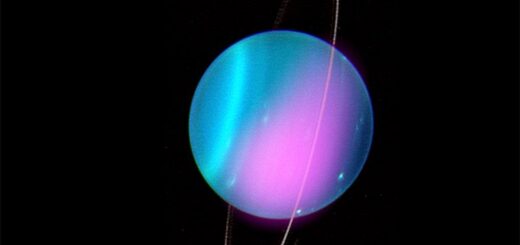Three Potentially Habitable Worlds Found In The Constellation Of Aquarius

– Three planets with sizes and temperatures similar to those of Venus and Earth, orbiting an ultra-cool dwarf star just 40 light-years from Earth, have been discovered by astronomers using the TRAPPIST telescope at ESO’s La Silla Observatory.
Astronomers led by Michaël Gillon of the University of Liège have focused their observations on star 2MASS J23062928-0502285, now also known as TRAPPIST-1.
They found that this dim and cool star faded slightly at regular intervals, indicating that several objects were passing between the star and the Earth. Detailed analysis showed that three planets are present around the star.
TRAPPIST-1 is an ultra-cool dwarf star — it is much cooler and redder than the Sun and barely larger than Jupiter. Despite being so close to the Earth, this star is too dim and too red to be seen with the naked eye or even visually with a large amateur telescope.
It lies in the constellation of Aquarius (The Water Carrier).
Follow-up observations with larger telescopes, including the HAWK-I instrument on ESO’s 8-metre Very Large Telescope in Chile, have shown that the planets orbiting TRAPPIST-1 have sizes very similar to that of Earth.
Two of the planets have orbital periods of about 1.5 days and 2.4 days respectively, and the third planet has a less well-determined orbital period in the range 4.5 to 73 days.
“With such short orbital periods, the planets are between 20 and 100 times closer to their star than the Earth to the Sun. The structure of this planetary system is much more similar in scale to the system of Jupiter’s moons than to that of the Solar System,” explains Michaël Gillon.
Although they orbit very close to their host dwarf star, the inner two planets only receive four times and twice, respectively, the amount of radiation received by the Earth, because their star is much fainter than the Sun.
That puts them closer to the star than the so-called habitable zone for this system, defined as having surface temperatures where liquid water can exist, although it is still possible that they possess potentially habitable regions on their surfaces.
The third, outer, planet’s orbit is not yet well known, but it probably receives less radiation than the Earth does, but maybe still enough to lie within the habitable zone.
NASA’s Hubble Space Telescope and K2, the Kepler spacecraft’s second mission, will be observing TRAPPIST-1 and its planets later this year.
The new results are published in the journal Nature.
NASA



 Creators of mankind
Creators of mankind Description of “Tall white aliens”
Description of “Tall white aliens” Where they came from?
Where they came from? About hostile civilizations
About hostile civilizations The war for the Earth
The war for the Earth “Tall white aliens” about eternal life
“Tall white aliens” about eternal life Video: “Nordic aliens”
Video: “Nordic aliens” Aliens
Aliens Alien encounters
Alien encounters The aliens base
The aliens base UFO
UFO Technology UFO
Technology UFO Underground civilization
Underground civilization Ancient alien artifacts
Ancient alien artifacts Military and UFO
Military and UFO Mysteries and hypotheses
Mysteries and hypotheses Scientific facts
Scientific facts


















